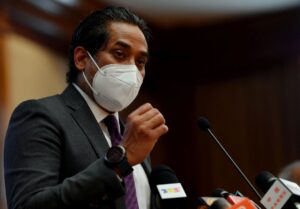
About the author: Céline R. Gounder is an internist, infectious-disease specialist, and epidemiologist at the NYU Grossman School of Medicine and Bellevue Hospital. She is also the host of the podcast Epidemic.
Doctors and scientists need to have an honest conversation with the American people about what the goals of COVID-19 vaccination are and how the pandemic will end. Even without the rise of the Delta variant, no one should be surprised to see some people develop infections a few months after vaccination. Though there may be value in eventually giving an additional dose or two to strengthen protection against disease, we’re unlikely to prevent all infections with booster shots. But the key message is that if you’re vaccinated, you’re well protected against life-threatening disease. If we can’t prevent all infections, what’s the endgame? A July COVID-19 outbreak in Provincetown, Massachusetts, offered a preview of what America’s post-pandemic future might look like. Almost three-quarters of the people who became infected with the coronavirus there were fully vaccinated, and most had symptoms of a bad head cold. Lost in most media coverage was that only 1 percent of fully vaccinated people who became infected were hospitalized. No fully vaccinated person died from COVID-19. This should have been cause for celebration. In a scenario in which some people might still become infected but very few get seriously ill, are hospitalized, or die, we can move from a public-health emergency to a more normal life. Vaccines alone won’t prevent all infections or eliminate the coronavirus, but widespread vaccination could turn COVID-19 into something more like influenza. As a society, Americans have shown that we are willing to live with 12,000 to 60,000 deaths from influenza each year. COVID-19 is more dangerous than the flu. Approximately 630,000 Americans have died of the coronavirus to date. But if we could cut the death rate by 90 percent or more, it would be on par with what we see in a bad flu season. We don’t shut down the economy for the flu. We socialize normally during flu season. Americans have to recalibrate our expectations about what makes a vaccine successful. The public discussion of the pandemic has become distorted by a presumption that vaccination can and should eliminate COVID-19 entirely. Under such an unattainable standard, each breakthrough infection looks like evidence that the vaccines are not working. But in reality, they continue to perform extremely well. Many Americans’ unrealistic expectations of the COVID-19 vaccines may have originated with real-world evidence published by the CDC in March, showing that in the first couple of months after vaccination, two doses of the Pfizer or Moderna vaccine were 90 percent effective at preventing SARS-CoV-2 infections, not just disease. People, including many experts, took this to mean that vaccinated people basically couldn’t get infected and couldn’t transmit the virus to others. This set the stage for the CDC to say that fully vaccinated people no longer needed to wear a mask in most situations. Many Americans believed that if they were vaccinated, they couldn’t get COVID-19 and could end all precautions. But longer-term follow-up showed that vaccine effectiveness against infection later dropped to 66 percent. Responding to public anxieties about such findings, the Biden administration declared last week that it would offer Americans booster shots beginning in late September. “With 170 million Americans knowing that they were seeing waning immunity in their vaccine … we needed to take the responsible action to plan ahead,” CDC Director Rochelle Walensky said. Many scientists, including me, were confounded by this announcement. It gave the impression that the vaccines needed to be bolstered as soon as possible in the United States—even if that meant sending fewer doses to countries where the need is greater. And the CDC’s focus on “waning immunity” may help spread misconceptions about how vaccines actually work. Shots in arms are much better at preventing disease than preventing infection. After vaccination against any virus, your immune system generates antibodies that can neutralize that virus, but those antibody levels will drop over time. If your antibody levels didn’t drop after every infection or vaccination, your blood would eventually turn into a thick sludge full of antibodies to every pathogen you have ever been exposed to. High neutralizing-antibody levels soon after vaccination are predictive of high vaccine effectiveness. But when those levels inevitably fall, you still have protection against severe disease. That’s because vaccination also spurs your immune system to make memory cells, which rev up antibody production if you’re later exposed to that virus again. After vaccination, though, your immune system’s memory needs three to five days to kick in. Vaccines are most effective at preventing infection with viruses that have a long incubation period, such as measles and smallpox; the immune system’s memory kicks in before the virus can fully establish itself in your body. But some invaders, such as influenza and the coronavirus, have a shorter incubation period, so vaccines are less likely to entirely block infection. In other words, the virus can still enter your nose and throat and start replicating. But vaccines also stimulate branches of the immune system, including T cells, that don’t prevent infection but are important in controlling disease. This results in a shorter duration of infection and possibly lower amounts of infectious virus in the body, which in turn translates into milder disease and possibly less transmission. (When doctors and scientists talk about “mild” COVID-19, they mean that the coronavirus isn’t wreaking havoc in your lungs, causing your oxygen levels to plummet, and endangering your life. You may still feel really sick, but you can recover safely in your own bed.) Shots also do a better job of inducing immune responses in the bloodstream and internal organs than they do on mucosal surfaces such as the mouth, nose, and throat. Yet respiratory pathogens such as the coronavirus and the influenza virus enter our bodies through these mucosal surfaces. So, while vaccines do an excellent job of blocking viral replication from progressing in the lungs, they are not as effective at preventing initial infection in the upper airway. You see that level of protection against infection in the upper airway only soon after vaccination, when neutralizing-antibody levels are at their peak. Unfortunately, health experts and public officials have done a poor job of explaining that while vaccines provide partial protection to individuals against infection and transmission, their most important benefit is at the population level. The more people get vaccinated, the less transmission occurs in the community, reducing everyone’s risk of infection. Over the long term, other precautions, such as better ventilation and air filtration, can reduce the risk even further. And just as face coverings became the norm for many people in East Asia after outbreaks of SARS and the avian flu, they will likely become part of America’s COVID-19 endgame too—at least during times of the year when respiratory infections are most likely to spread.
Because early data on vaccine effectiveness reinforced the perception that the vaccines could block all infections, news that they do not has unnecessarily shaken many Americans’ confidence. The goal isn’t to eliminate SARS-CoV-2 infections. We can’t, no matter how many booster shots the United States gives. The goal is to slow the spread, save lives, and eventually turn COVID-19 into something much less deadly—something more like the flu.




